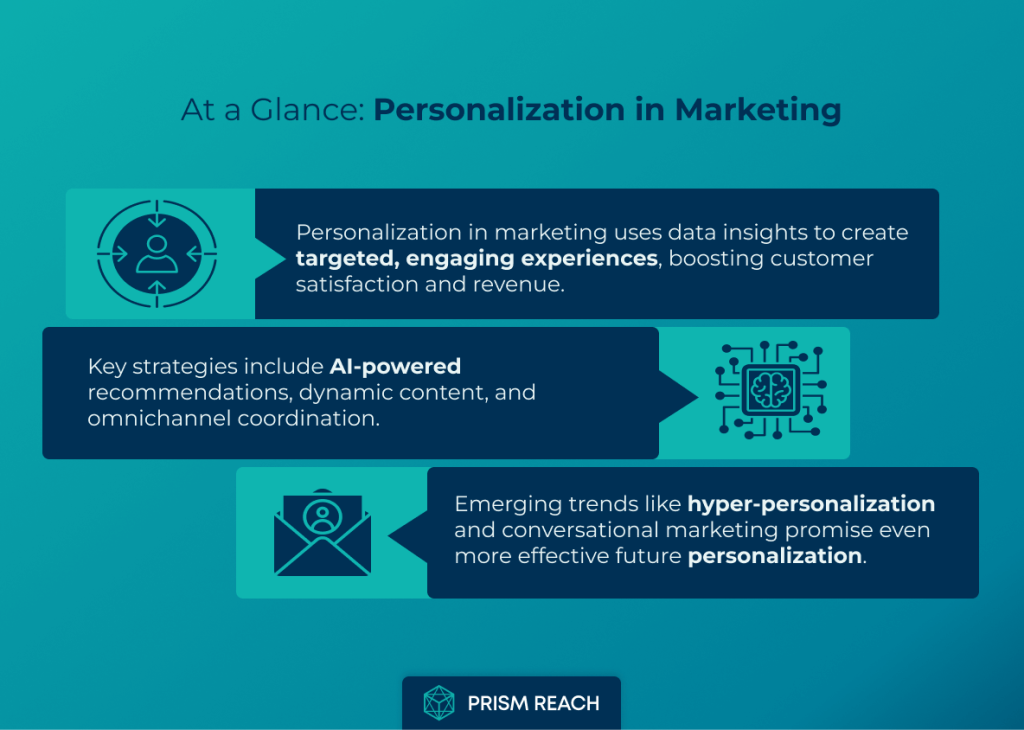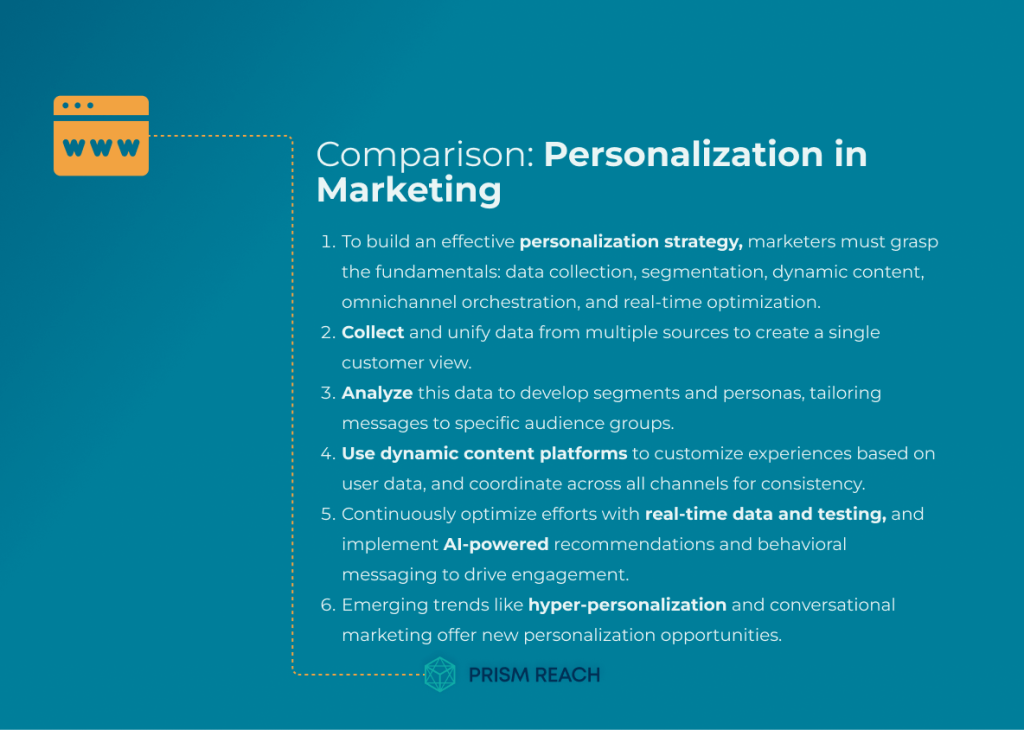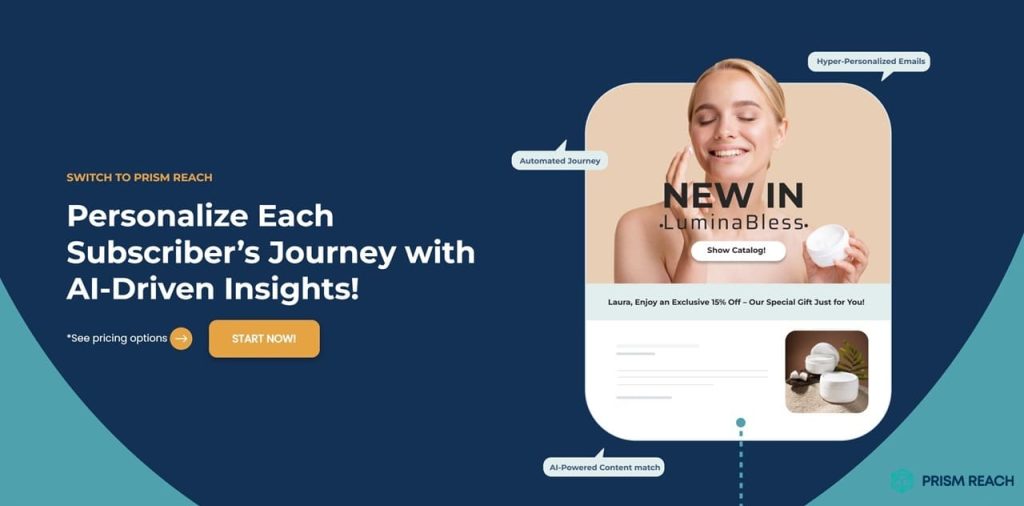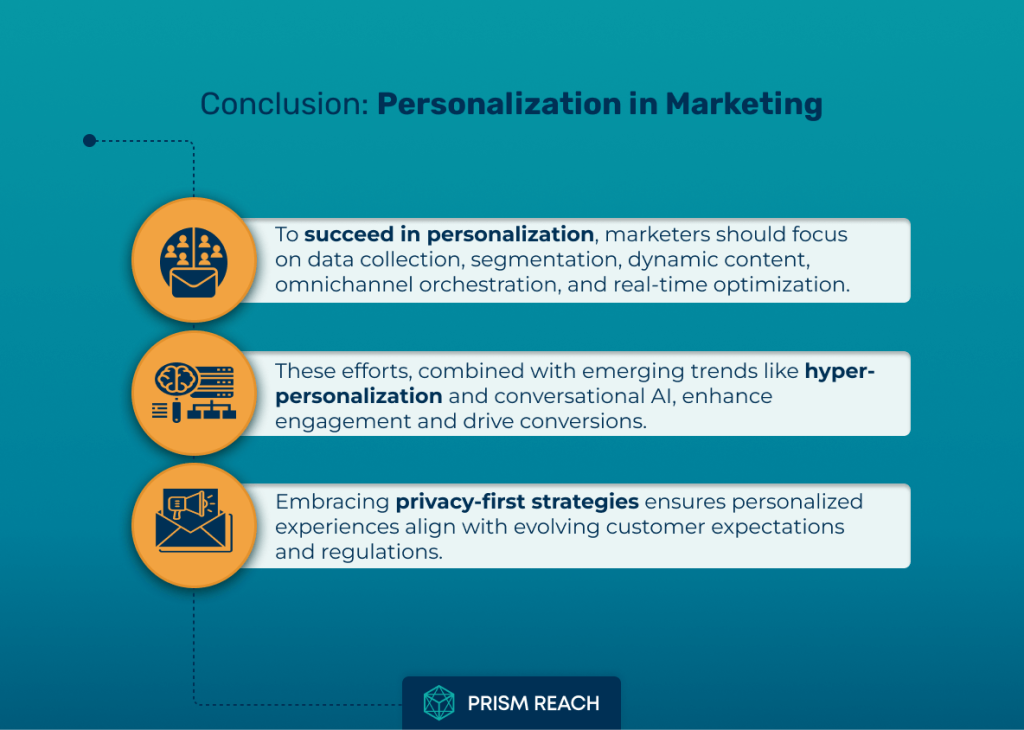In the age of digital transformation, personalization has emerged as a game-changer in the world of marketing. By leveraging data-driven insights and advanced technologies, businesses can now deliver highly targeted, relevant, and engaging experiences to their customers. This approach not only enhances customer satisfaction and loyalty but also drives significant improvements in conversion rates and revenue growth.
What is Personalization in Marketing?
Personalization in marketing refers to the practice of tailoring marketing messages and experiences to individual customers based on their unique preferences, behaviors, and data. Unlike generic marketing strategies that treat all customers the same, personalized marketing recognizes the distinct needs and interests of each customer, allowing businesses to deliver more relevant and impactful communications.
Upgrade Your Email Marketing with AI Personalization!
The Importance of Personalization in Marketing
You might be wondering, does personalization truly matter in the grand scheme of marketing? The answer is a resounding yes. Numerous studies have demonstrated the profound impact of personalized marketing on consumer behavior and business outcomes. For instance, a report by Epsilon revealed that 80% of consumers are more likely to purchase from brands that offer personalized experiences. Moreover, personalized email campaigns generate 29% higher unique open rates and 41% higher unique click rates compared to non-personalized emails.
By treating your subscribers as individuals with unique needs, preferences, and behaviors, you demonstrate that you value their engagement and are committed to providing them with the most relevant and personalized content. This approach not only improves the overall user experience but also fosters a stronger sense of connection and loyalty between your brand and your subscribers.
Moreover, personalization allows you to deliver the right message to the right person at the right time. By tailoring your content and offers based on specific subscriber characteristics, such as demographics, interests, or past interactions with your brand, you can increase the likelihood of conversion and drive more meaningful engagement. This targeted approach also helps you avoid the pitfalls of generic, one-size-fits-all messaging that can lead to lower engagement rates and higher unsubscribe rates.
In today’s competitive digital landscape, where consumers are bombarded with countless marketing messages daily, personalization has become a critical strategy for cutting through the noise and delivering value to your subscribers. By embracing personalization, you can differentiate your brand, build stronger relationships with your audience, and ultimately achieve better marketing results.

Key Elements of Personalization
To create a successful personalization strategy, marketers must understand the fundamental building blocks that enable targeted, relevant experiences. These key elements include:
- Data Collection and Unification: Gathering comprehensive customer data from various sources, such as website interactions, purchase history, social media engagement, and CRM systems. Unifying this data into a single customer view is crucial for gaining a holistic understanding of each individual.
- Segmentation and Persona Development: Analyzing customer data to identify distinct segments based on shared characteristics, preferences, and behaviors. Creating detailed buyer personas for each segment helps in crafting targeted messaging and experiences that resonate with specific audience groups.
- Dynamic Content Creation: Tailoring content, offers, and recommendations to individual users or segments. Utilizing dynamic content platforms like Prism Reach enables the creation of customized email content based on subscriber data points such as location, interests, and past interactions.
- Omnichannel Orchestration: Coordinating efforts across all customer touchpoints, including email, social media, website, mobile apps, and in-store interactions. This requires a well-integrated marketing technology stack and a cohesive strategy that ensures data and content flow smoothly between channels.
- Real-Time Optimization and Testing: Continuously refining personalization strategies based on real-time data and insights. Leveraging AI and machine learning algorithms allows marketers to optimize content, offers, and experiences in real-time, ensuring maximum relevance and effectiveness. A/B testing and multivariate testing are also crucial for identifying the best-performing variations and improving overall personalization efforts.
9 Proven Strategies for Maximizing the Impact of Personalization
To maximize the impact of your personalization efforts, consider the following strategies:
1. Implement AI-Powered Product Recommendations
Harness the potential of artificial intelligence to deliver highly accurate and relevant product recommendations to individual users. By analyzing user behavior, purchase history, and preferences, AI algorithms can suggest products that are most likely to appeal to each customer, thereby increasing the likelihood of conversion and customer satisfaction. For example, Amazon attributes 35% of its revenue to its AI-powered recommendation engine.
2. Implement Dynamic Email Content
Email marketing remains one of the most effective channels for personalization. By utilizing platforms like Prism Reach, marketers can create dynamic email content that adapts to each subscriber’s unique characteristics and behaviors. This can include personalized subject lines, product recommendations, and content blocks that change based on factors such as location, past purchases, and email engagement history. Studies have shown that personalized subject lines can increase open rates by 26%.
3. Create Personalized Website Experiences
Extend personalization beyond email to deliver customized website experiences for different visitor segments. This can involve displaying tailored product recommendations, offers, and content based on a visitor’s browsing history, geolocation, or customer profile. Tools like Adobe Target and Optimizely enable marketers to create and test personalized website experiences, resulting in higher engagement and conversion rates. A study by Monetate found that personalized website experiences can lift conversion rates by up to 15%.
4. Trigger Behavioral-Based Messaging
Automated, personalized messages triggered by specific user actions or milestones can be highly effective in driving engagement and conversions. Examples include cart abandonment emails, post-purchase follow-ups, and birthday or anniversary offers. By sending relevant, timely messages based on user behavior, businesses can demonstrate attentiveness and build stronger customer relationships. A case study by Recart showed that cart abandonment emails with personalized product recommendations generated a 15.8% conversion rate.

5. Embrace Account-Based Marketing (ABM)
For B2B companies, account-based marketing offers a targeted approach to personalization. By identifying key decision-makers within specific organizations and delivering highly customized content and experiences, marketers can effectively nurture leads and accelerate the sales cycle. ABM tactics can include personalized landing pages, targeted advertising, and customized email campaigns. A study by ITSMA found that 87% of marketers who measure ROI say that ABM outperforms other marketing investments.
6. Capitalize on Location-Based Marketing
With the proliferation of mobile devices and geolocation technology, marketers can now deliver hyper-relevant, real-time experiences based on a customer’s current location. This can include targeted mobile push notifications, in-app offers, and personalized store experiences. Starbucks, for instance, uses its mobile app to send personalized offers and promotions to customers when they are near a store location, resulting in increased foot traffic and sales.
7. Invest in Predictive Analytics
Predictive analytics enables marketers to anticipate customer needs and preferences, allowing for proactive personalization efforts. By analyzing historical data and applying machine learning algorithms, businesses can predict future customer behavior, such as the likelihood of churn or the next best product to offer. This insight can then be used to create targeted retention campaigns or personalized cross-sell and upsell offers. A study by Aberdeen Group found that companies using predictive analytics achieve a 21% increase in customer retention rates.
8. Develop Persona-Based Content Journeys
Creating detailed buyer personas is just the first step in personalization. To truly engage and convert each persona, marketers must develop tailored content journeys that guide individuals through the funnel with relevant, personalized messaging. This involves mapping out the key stages of the customer journey, identifying the most appropriate content formats and channels for each stage, and crafting compelling narratives that resonate with each persona’s unique needs and preferences. By delivering the right content at the right time, businesses can build trust, establish thought leadership, and ultimately drive conversions.
9. Foster Loyalty with Exclusive Experiences
Personalization can play a significant role in building long-term customer loyalty. By offering exclusive, personalized experiences and benefits to loyalty program members, businesses can create a sense of belonging and appreciation that keeps customers coming back. Nike, for example, offers its NikePlus members access to personalized product recommendations, early access to new releases, and invitations to exclusive events. These perks not only encourage repeat purchases but also foster a deeper emotional connection between the brand and its customers.

Advanced Personalization Strategies: Hidden Gems
While the foundational elements of personalization are essential, integrating advanced strategies can significantly enhance its effectiveness. Here are five “hidden gems” strategies that are not widely recognized but can transform your personalization efforts:
- Zero-Party Data Utilization:
Strategy: Encourage customers to share preferences and interests directly through surveys or quizzes, creating zero-party data that can inform personalized marketing efforts.- Effectiveness: High; this data is explicitly provided by customers, leading to more accurate personalization.
- Obscurity: Many brands rely heavily on third-party data rather than engaging customers for insights.
- Ease of Implementation: Requires initial setup for surveys but can be easily integrated into existing marketing strategies.
- Uniqueness: Focuses on customer-driven insights rather than inferred data, enhancing trust and engagement.
- Intent-Based Marketing:
Strategy: Use intent data to tailor marketing messages based on what prospects are actively researching or showing interest in.- Effectiveness: Very high; aligns messaging with customer needs at critical points in their buyer journey.
- Obscurity: While intent-based strategies exist, they are often underutilized compared to demographic targeting.
- Ease of Implementation: Requires access to intent data tools but is increasingly feasible with modern analytics platforms.
- Uniqueness: Emphasizes timing and relevance based on active interest rather than static profiles.
- Conversational Personalization:
Strategy: Implement chatbots or live chat features that use customer data to personalize interactions in real-time.- Effectiveness: High; personalized conversations can significantly enhance user experience and conversion rates.
- Obscurity: Many brands use chatbots but do not leverage them for personalized interactions based on user history.
- Ease of Implementation: Moderately easy; requires chatbot setup and integration with CRM systems.
- Uniqueness: Transforms standard customer service into a personalized experience.
- AI-Powered Personalization Engines:
Strategy: Leverage AI algorithms to analyze customer data and automate personalized recommendations across channels.- Effectiveness: Extremely high; AI can process vast amounts of data quickly, delivering timely and relevant personalization at scale.
- Obscurity: While AI usage is growing, its application specifically for personalization remains underexplored by many companies.
- Ease of Implementation: Requires investment in AI tools but offers significant long-term benefits once integrated.
- Uniqueness: Harnesses advanced technology to enhance personalization beyond traditional methods.
- Real-Time Personalization Based on User Behavior:
Strategy: Implement systems that adjust content or offers in real-time based on user actions (e.g., browsing history, time spent on a page).- Effectiveness: Extremely high; real-time adjustments create highly relevant experiences that can lead to immediate conversions.
- Obscurity: Many brands have static content delivery without adapting to real-time behavior changes.
- Ease of Implementation: Requires sophisticated tracking systems but is becoming more accessible with modern technology.
- Uniqueness: Focuses on immediate relevance, enhancing the overall shopping experience dynamically.
Jumpstart Your Personalization Strategy with Prism Reach
Maintaining and enhancing your personalization efforts requires diligent effort and the right tools. This is where Prism Reach comes into play. Prism Reach is an innovative AI-powered SaaS solution designed to enhance the effectiveness of email marketing campaigns through deep personalization and automation. By leveraging Prism Reach, you can streamline your email marketing processes, ensure high deliverability rates, and maintain a stellar sender reputation.
Key Benefits of Prism Reach
- AI-Powered Personalization: Prism Reach utilizes sophisticated AI algorithms to create detailed user avatars based on subscriber behavior and preferences. This enables the creation of highly personalized email content that resonates with each individual recipient.
- Dynamic Content Selection: The platform‘s ability to dynamically select and tailor content based on real-time data ensures that your emails are always relevant and engaging to your audience.
- Performance Monitoring: Prism Reach provides robust tracking tools to monitor the effectiveness of your email campaigns, including open rates, click-through rates, and engagement metrics. This data-driven approach allows for continuous optimization and improvement of your email strategies.
Prism Reach’s Features Enhancing Personalization
- Content Clustering: Groups website content and social media posts into relevant categories, enabling targeted messaging in your emails.
- User Avatars: Creates personalized profiles for each subscriber, ensuring that email content can be tailored to individual preferences and behaviors.
- AI-Generated CTAs: Automatically generates and updates CTAs in your emails based on subscriber interactions and seasonal trends, enhancing engagement and deliverability.

How Prism Reach Enhances Your Email Marketing
By leveraging Prism Reach, businesses can transform their email marketing efforts from basic communication tools into dynamic, personalized experiences that drive engagement and maintain a strong sender reputation. Here’s how Prism Reach can elevate your email marketing strategy:
- Personalized Content: Prism Reach analyzes subscriber data to deliver personalized content that aligns with individual preferences, increasing engagement and reducing spam complaints.
- Automated Campaigns: Automate your email campaigns with intelligent scheduling and content curation, ensuring timely and relevant communication with your audience.
- Real-Time Monitoring: Keep a close eye on your sender reputation with real-time monitoring tools that alert you to any potential issues, allowing you to take proactive measures.
Upgrade Your Email Marketing with AI Personalization!
Conclusion
Personalization has become a critical differentiator for businesses looking to stand out and forge lasting connections with their customers. By harnessing the power of data, technology, and creativity, marketers can craft experiences that resonate on a deeper, more personal level, driving engagement, loyalty, and revenue growth.
As you navigate the complex world of personalization, remember to prioritize customer-centricity, maintain transparency, and continuously iterate based on data-driven insights. Implementing advanced strategies like zero-party data utilization, intent-based marketing, conversational personalization, AI-powered personalization engines, and real-time personalization based on user behavior can set your campaigns apart in a crowded inbox.
With the right strategies and tools, such as Prism Reach, you can unlock the full potential of personalization and take your marketing efforts to new heights. Embrace personalization to build stronger relationships, enhance customer experiences, and drive significant business results.
Sources
- McKinsey: The Future of Personalization and How to Get Ready for It
- Monetate: Personalization Development Study
- MoEngage: Examples of Personalization
- Xerago: Effective Marketing Personalization Strategies
- TechTarget: Examples of Personalization Strategiesstudy